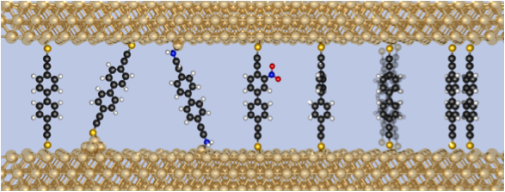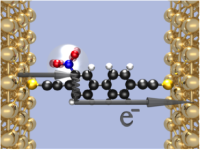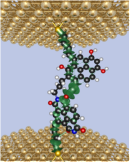Theory of Ultrafast Spectroscopy, Energy and Charge Transfer - Hansen Group
We are two theoretical groups in the Department of Chemistry studying charge and energy transport through molecules. We are interested in conducting junctions, solar cells and photosynthetic protein complexes.
The Hansen group focuses on its major project “Charge Transfer and Catalysis in Metalloproteins” funded by the Lundbeck Foundation. With collaborators in Lund, Sweden, Thorsten The Hansen group focuses on its major project “Charge Transfer and Catalysis in Metalloproteins” funded by the Lundbeck Foundation. With collaborators in Lund, Sweden, Thorsten Hansen continues a project on the quantum dynamics of photosynthesis funded by the Swedish Research Council (VR).
In August, Gemma Solomon and Thorsten Hansen cohosted an International Workshop on: Charge, Heat and Energy Transport in Molecular Junctions celebrating the 60th birthday of Professor Vladimiro Mujica.
Understanding chemical trends in molecular electron transport
Traditionally, chemistry has involved the study of molecules in solution, the gas phase or as solid crystals. Today, nanofabrication techniques have made it possible to bind molecules in a huge array of different environments and we need to understand how different chemical functionalities influence properties like conductivity.

We are particularly interested in quantum interference effects in molecular electron transport and how simple changes in conjugation can result in dramatically different transport properties.
Local heating, dissipation and thermoelectric response of molecules in conducting junctions

As current passes through a molecule, the tunneling electrons can gain or lose energy through their interactions with the vibrational degrees of freedom. This results in an inelastic electron tunneling spectrum, a type of vibrational spectroscopy, but can also induce changes in the molecule. We are interested in how to modulate these excitation and dissipation processes with chemical modifications to the system.

Mapping transport pathways in complex systems
Structure-function relationships play a great role in the development of chemical intuition and we use local transport decomposition methods to map the transport pathways in complex systems. As molecules fluctuate, both due to thermal motion or an applied force, the conduction pathways can also fluctuate and we study which parts of a molecule actually carry the current and which parts merely control the environment.
32. “Interference-induced electron- and hole-conduction asymmetry” S. Wohlthat, G. C. Solomon, N. S. Hush and J. R. Reimers, Theor Chem Acc., 2011,130 , 815-828
31. “Tunneling Currents That Increase with Molecular Elongation” I. Franco, G. C. Solomon, G. C. Schatz and M. A. Ratner, J. Am. Chem. Soc., 2011, 133, 15714-15720
30. “Understanding and Controlling Crosstalk between Parallel Molecular Wires” M. G. Reuter, G. C. Solomon T. Hansen, T. Seideman and M. A. Ratner, J. Phys. Chem. Lett.,2011, 2, 1667-1671
29. “Designing organic spin filters in the coherent tunneling regime” C. Herrmann, G. C. Solomon and M. A. Ratner, J. Chem. Phys., 2011, 134, 224306 (9 pages)
28. “Novel Quantum Interference Effects in Transport through Molecular Radicals” J. P. Bergfield, G. C. Solomon, Charles A. Stafford and Mark A. Ratner, Nano Lett., 2011, 11, 2759-2764
27. “Evidence for Quantum Interference in SAMs of Arylethynylene Thiolates in Tunneling Junctions with Eutectic Ga-In (EGaIn) Top-Contacts” D. Fracasso, H. Valkenier, J. C. Hummelen, G. C. Solomon and R. C. Chiechi, J. Am. Chem. Soc., 2011, 133, 9556-9563
26. “Mechanically Activated Molecular Switch through Single-Molecule Pulling” I. Franco, C. B. George, G. C. Solomon, G. C. Schatz and M. A. Ratner, J. Am. Chem. Soc., 2011, 133, 2242-2249
25. “Local Pathways in Coherent Electron Transport through Iron Porphyrin Complexes: A Challenge for First-Principles Transport Calculations” C. Herrmann, G. C. Solomon and M. A. Ratner, J. Phys. Chem. C, 2010, 114, 20813-20820
24. “Controlling Electron Transfer in Donor−Bridge−Acceptor Molecules Using Cross-Conjugated Bridges ” A. Butler Ricks, G. C. Solomon, M. T. Colvin, A. M. Scott, K. Chen, M. A. Ratner and M. R. Wasielewski, J. Am. Chem. Soc., 2010, 132, 15427-15434
23. “Unidirectional hopping transport of interacting particles on a finite chain” M. Einax, G. C. Solomon, W. Dieterich and A. Nitzan, J. Chem. Phys., 2010, 133, 054102
22. “Understanding Coherent Transport through π-Stacked Systems upon Spatial Dislocation” G. C. Solomon, J. Vura-Weis, C. Herrmann, M. R. Wasielewski and M. A. Ratner, J. Phys. Chem. B, 2010, 114, 14735-14744
21. “The Chameleonic Nature of Electron Transport through π-Stacked Systems ” G. C. Solomon, C. Herrmann, J. Vura-Weis, M. R. Wasielewski and M. A. Ratner, J. Am. Chem. Soc., 2010, 132, 7887-7889
20. “Organic Radicals As Spin Filters” C. Herrmann, G. C. Solomon and M. A. Ratner, J. Am. Chem. Soc., 2010, 132, 3682-3684
19. “Exploring local currents in molecular junctions” G. C. Solomon, C. Herrmann, T. Hansen, V. Mujica and M. A. Ratner, Nature Chemistry, 2010, 2, 223-228
18. “Chemical Control of the Photoluminescence of CdSe Quantum Dot-Organic Complexes with a Series of Para-Substituted Aniline Ligands” K. E. Knowles, D. B. Tice, E. A. McArthur, G. C. Solomon and E. A. Weiss, J. Am. Chem. Soc., 2010, 132, 1041-1050
17. “Ghost transmission: How large basis sets can make electron transport calculations worse” C. Herrmann, G. C. Solomon, J. E. Subotnik, V. Mujica and M. A. Ratner, J. Chem. Phys., 2010, 132, 024103
16. “Interfering pathways in benzene: An analytical treatment” T. Hansen, G. C. Solomon, D. Q. Andrews and M. A. Ratner, J. Chem. Phys., 2009, 131, 194704
15. “Electron transport through conjugated molecules: When the π system only tells part of the story” G. C. Solomon, D. Q. Andrews, R. P. Van Duyne and M. A. Ratner,ChemPhysChem, 2009, 10, 257-264
14. “Single Molecule Electronics: Increasing dynamic range and switching speed using cross- conjugated species” D. Q. Andrews, G. C. Solomon, R. P. Van Duyne and M. A. Ratner, J. Am. Chem. Soc., 2008, 130(51), 17309-17319
13. “Quantum interference in acyclic systems: The conductance of cross-conjugated molecules” G. C. Solomon, D. Q. Andrews, R. H. Goldsmith, T. Hansen, M. R. Wasielewski, R. P. Van Duyne and M. A. Ratner, J. Am. Chem. Soc., 2008, 130(51), 17301-17308
12. “Quantum interference: The structural dependence of electron transmission through model systems and cross-conjugated molecules” D. Q. Andrews, G. C. Solomon, R. H. Goldsmith, T. Hansen, M. R. Wasielewski, R. P. Van Duyne and M. A. Ratner, J. Phys. Chem. C, 2008, 112(43), 16991-16998
11. “Understanding quantum interference in coherent molecular conduction” G. C. Solomon, D. Q. Andrews, T. Hansen, R. H. Goldsmith, M. R. Wasielewski, R. P. Van Duyne and M. A. Ratner, J. Chem. Phys., 2008, 129, 054701, 8 pages
10. “When Things Are Not as They Seem: Quantum Interference Turns Molecular Electron Transfer “Rules” Upside Down” G. C. Solomon, D. Q. Andrews, R. P. Van Duyne and M. A. Ratner, J. Am. Chem. Soc., 2008, 130(25), 7788-7789
9. “The Green’s-Function Density-Functional Tight-Binding (gDFTB) Method for Molecular- Electronic Conduction.” J. R Reimers, G. C. Solomon, A. Gagliardi, A. Bilic ́, N. S. Hush, T. Frauenheim, A. Di Carlo and A. Pecchia, J. Phys. Chem. A, 2007, 111(26), 5692
8. “A general apriori method for propensity rules of the Inelastic Electron Tunneling Spectroscopy of single-molecule conduction” A. Gagliardi, G. C. Solomon, A. Pecchia, T. Frauenheim, A. Di Carlo, N. S. Hush and J. R. Reimers, Phys. Rev. B, 2007, 75, 174306
7. “The molecular origins of conduction channels observed in shot noise measurements.” G. C. Solomon, A. Gagliardi, A. Pecchia, T. Frauenheim, A. Di Carlo, J. R. Reimers and N. S. Hush, Nano Letters, 2006, 6(11), 2431-2437
6. “The symmetry of single molecule conduction” G. C. Solomon, A. Gagliardi, A. Pecchia, T. Frauenheim, A. Di Carlo, J. R. Reimers and N. S. Hush, J. Chem. Phys.,2006, 125(18), 184702
5. “Physics-Based Molecular Device Model in a Transient Circuit Simulator” N. M. Kriplani, D. P. Nackashi, C. J. Amsinck, N. H Di Spigna, M. B Steer, P. D. Franzon, R. L Rick, G. C Solomon and J. R. Reimers, Chemical Physics, 2006, 326, 188-196
4. “Understanding the inelastic electron-tunneling spectra of alkanedithiols on gold” G. C. Solomon, A. Gagliardi, A. Pecchia, A. Di Carlo, T. Frauenheim, J. R. Reimers and N. S. Hush, J. Chem. Phys., 2006, 124, 094704
3. “Overcoming Computational Uncertainties To Reveal Chemical Sensitivity in Single Molecule Conduction Calculations” G. C. Solomon, J. R. Reimers and N. S. Hush, J. Chem. Phys., 2005, 121, 224502
2. “Molecular Electronics: From Basic Chemical Principles to Photosynthesis to Steady-State Through-Molecule Conductivity to Computer Architictures” J. R. Reimers, A. Bilic, Z.-L. Cai, M. Dahlbom, N. A. Lambropoulos, G. C. Solomon, M. J. Crossley and N. S. Hush, Aust. J. Chem, 2004, 57, 1133
1. “Single molecule conductivity: The role of junction-orbital degeneracy in the artificially high currents predicted by ab initio approaches.” G. C. Solomon, J. R. Reimers and N. S. Hush J. Chem. Phys., 2004, 121(14), 6615
Contact
Thorsten Hansen
Associate Professor
Office: C314A
Phone: +45 2229 5728
E-mail: thorsten@chem.ku.dk
